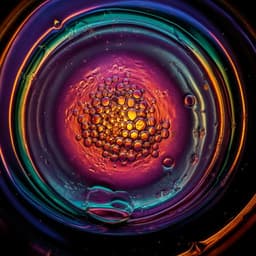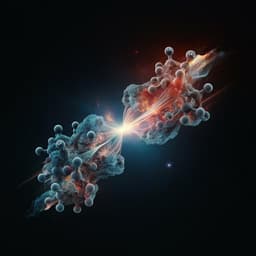
Materials Science
Structural changes during glass formation extracted by computational homology with machine learning
A. Hirata, T. Wada, et al.
Discover how Akihiko Hirata, Tomohide Wada, Ippei Obayashi, and Yasuaki Hiraoka utilized computational persistent homology and machine learning to unveil critical insights into the glass formation process of metallic glasses. Their findings reveal a transformative shift in atomic structures during cooling, paving the way for a deeper understanding of glass states.
~3 min • Beginner • English
Introduction
Glass states form due to a rapid increase in viscosity upon cooling from liquids and are far from equilibrium because of extremely long relaxation times. Their structures, as seen in structure factors, show only broad peaks and lack clear distinctions between liquid and glass, making it challenging to identify structural signatures of glass formation or to differentiate glasses produced at different cooling rates. While molecular dynamics (MD) simulations provide complete atomic positions and have revealed slight cooling-rate–dependent changes via Voronoi and bond-orientational analyses, such descriptors are system-dependent and primarily capture short-range order, leaving medium-to-extended-range features elusive. The study aims to develop and apply analytical methodologies—persistent homology combined with machine learning—to reveal hidden, statistically significant structural features governing metallic glass formation and their dependence on cooling rate.
Literature Review
Prior MD studies probed cooling-rate effects in various glass-forming systems, identifying small changes in local motifs (e.g., icosahedral-like clusters) via Voronoi polyhedra and bond-orientational order, with trends depending on the potential and alloy system. However, these methods are limited to short-range order and are system-specific. Persistent homology emerged as a tool to characterise hierarchical, three-dimensional structural features (e.g., rings and voids) in disordered materials and has been applied to oxide and metallic glasses, providing persistence diagrams that encode creation/annihilation of topological features as atomic radii vary. The present work builds on this by integrating persistent homology with linear machine learning (PCA, linear regression) to statistically extract the structural components most correlated with cooling rate.
Methodology
- Materials and MD simulation: Amorphous Pd80Si20 models were generated using MD with embedded atom method (EAM) potentials (Sheng). Systems contained 12,000 atoms (9600 Pd, 2400 Si) in cubic periodic cells. Simulations used NPT ensemble (LAMMPS), Nose–Hoover thermostat/barostat. Initial configurations equilibrated at 2500 K (>50 ps), then cooled to 300 K at rates from 1.7×10^10 to 1.7×10^14 K s−1. Post-cooling stabilization at 300 K for 125 ps. - Datasets: For linear regression analysis (LRA), one model at each of 37 cooling rates (1.7×10^10–1.7×10^14 K s−1). For principal component analysis (PCA), 30 models each at five cooling rates (1.7×10^10, 1.7×10^11, 1.7×10^12, 1.7×10^13, 1.7×10^14 K s−1). Structure factors matched experiments; Si atoms have only Pd neighbors (no nearest-neighbor Si–Si). Short-range structures are Si-centered prism-type clusters (e.g., <0 3 6 0>, <0 4 4 0>, <0 5 4 0>, <0 2 8 0>, <0 3 6 1>). - Persistent homology: Persistence diagrams were computed for second homology (PD2) on Pd-only configurations (voids/closed holes) and first homology (PD1) on Si-only configurations (rings/open holes). Filtration corresponds to virtual increases of atomic radii. Each diagram plots birth (x-axis) and death (y-axis) of features. Characteristic PD2 islands correspond to individual prism-type clusters; PD1 horns reflect arrangements of Si-centered prisms. - Vectorization and ML: Diagrams were clipped to regions [1.2, 2.6]×[1.4, 2.8] (Pd) and [1.8, 4.0]×[2.1, 4.3) (Si), partitioned into 140×140 (Pd) and 110×110 (Si) grids. Histograms of birth–death pair counts per bin were smoothed and converted to persistence image vectors with parameters (σ, c, p) = (0.02, 1.0, 1.0) for Pd and (0.04, 1.0, 1.0) for Si. - Linear regression analysis: Ridge (L2) regularization with parameter 200 modeled linear relations between vector components and cooling rate across 37 rates. R^2 scores: 0.509 (PD2, Pd), 0.549 (PD1, Si). Learned coefficient vectors were used to reconstruct persistence diagrams highlighting regions most strongly associated with slower (blue) vs faster (red) cooling. - PCA: Vectors from 150 configurations (30 models×5 rates) were reduced to principal components. The first principal component (PC1) correlated strongly with cooling rate; contribution ratios: 0.754 (PD2, Pd), 0.675 (PD1, Si). Reconstructed diagrams from PC1 showed blue/red regions coincident with LRA, validating consistency. - Inverse analysis: Using HomCloud’s inverse method, geometric structures corresponding to selected high-weight birth–death bins were extracted from the original MD data. Key bins: Pd PD2 slowest-cooled [1.79,1.80]×[2.43,2.44], fastest-cooled [1.89,1.90]×[2.44,2.45]; Si PD1 slowest [2.38,2.40]×[2.70,2.72], fastest [2.01,2.05]×[3.07,3.11]. Extracted counts: Pd cavities 710 (slowest) vs 435 (fastest); Si rings 460 (slowest) vs 358 (fastest). Distortion of prism faces was quantified via triangle face areas; distributions compared between slowest and fastest-cooled samples. - Software and availability: Persistent homology and inverse analysis via HomCloud; ML via scikit-learn. Data available upon request; HomCloud is open-source. - Validation against conventional analyses: Partial PDFs (Pd–Pd, Pd–Si, Si–Si) and Voronoi polyhedra were computed; only subtle differences observed, underscoring higher sensitivity of the persistence homology approach. - Local S(Q): Local structure factors S(Q) for extracted superclusters were computed and compared to experimental neutron S(Q), focusing on second peak splitting.
Key Findings
- Persistent homology reveals cooling-rate–dependent structural signals: LRA and PCA highlight distinct regions in PD2 (Pd) and PD1 (Si) associated with slow vs fast cooling, with PC1 strongly correlated to cooling rate. - Individual prism clusters vs extended arrangements: PD2 islands map to individual Si-centered prism-type clusters of Pd; slight increase in distortion for prisms in fastest-cooled samples (broader triangle face-area distribution), but differences are modest. - Dominant change is extended-range order (superclusters): Inverse analysis of PD1 (Si) shows that slowest-cooled models feature compact superclusters composed of 3–4 prisms connected at vertices, whereas fastest-cooled models favor larger extended arrangements with 5–9 prisms. Histograms of supercluster size confirm larger extent in fast-cooled samples. - Specific PD regions and counts: Slowest-cooled Pd PD2 signal at [1.79,1.80]×[2.43,2.44] (710 cavities); fastest at [1.89,1.90]×[2.44,2.45] (435). Slowest-cooled Si PD1 signal at [2.38,2.40]×[2.70,2.72] (460 rings); fastest at [2.01,2.05]×[3.07,3.11] (358). - Statistical performance: LRA R^2 = 0.509 (PD2 Pd), 0.549 (PD1 Si); PCA contribution ratios 0.754 (PD2 Pd), 0.675 (PD1 Si). - Conventional analyses show minor differences: Partial PDFs show minimal change (Pd–Pd and Pd–Si nearly unchanged; slight Si–Si differences), and Voronoi indices do not capture systematic extended-range changes, highlighting the added sensitivity of the homology+ML approach. - Link to experimental glass signatures: Local S(Q) from 3–4 prism superclusters (slow-cooled) reproduces the experimental second peak splitting characteristic of glass; 5–9 prism structures (fast-cooled) do not, indicating that compact superclusters promote glassy structural order.
Discussion
The study addresses the challenge of identifying structural origins of glass formation and its cooling-rate dependence by moving beyond short-range descriptors. Persistent homology combined with linear ML isolates the specific topological signatures most sensitive to cooling rate. While individual prism-type clusters show only modest distortion changes with cooling, the predominant transformation occurs in the medium-to-extended range: slow cooling favors compact superclusters of 3–4 prisms that contribute to the characteristic second peak splitting in S(Q), indicating development of glassy order, whereas rapid cooling yields more extended 5–9 prism arrangements. The first principal component’s strong correlation with cooling rate suggests a low-dimensional structural order parameter embedded in the persistence diagrams. These findings imply that hierarchical arrangements of local motifs, rather than changes in motif identity alone, underlie the static structural evolution during vitrification. The approach may also enable extrapolations toward an ideal glass by locating expected positions on persistence diagrams via regression, and it distinguishes glass-preferential non-crystalline local configurations from crystalline counterparts.
Conclusion
By combining persistent homology with linear machine learning (PCA, ridge regression), the study statistically extracts cooling-rate–dependent structural features in Pd80Si20 metallic glass. The principal structural change during glass formation is the reorganization of Si-centered prism-type clusters into medium-range superclusters: compact 3–4 prism units dominate in slower-cooled glasses and correlate with experimental glass signatures (second peak splitting in S(Q)), whereas larger 5–9 prism assemblies are more prevalent in rapidly cooled states. Conventional PDF and Voronoi analyses miss these extended-range changes, underscoring the higher sensitivity of the homology-based framework. The methodology provides a systematic route to identify key hierarchical structures governing glass formation and can be extended to other glass systems to uncover general trends and potentially approach descriptors of ideal glass structures.
Limitations
- System and potential specificity: Results pertain to Pd80Si20 using a specific EAM potential; structural trends may vary with composition and interatomic potentials. - Timescale and cooling rate gap: MD-accessible cooling rates are orders of magnitude higher than experimental processing; extrapolation to real glasses is indirect. - Finite-size and snapshot-based analysis: 12,000-atom cells and single-snapshot models per rate (for LRA) may limit sampling of rare motifs; although PCA used multiple models, larger datasets could refine statistics. - Method parameter dependence: Persistence image parameters, grid choices, and regularization settings were tuned for interpretability; different choices may alter sensitivity. - Modest changes in individual motifs: Distortion differences in individual prisms are subtle, making conclusions about their role secondary to medium-range arrangements. - Generalizability: Only PD1 (Si) and PD2 (Pd) were analyzed; other homology dimensions or mixed-species filtrations might reveal additional features.
Related Publications
Explore these studies to deepen your understanding of the subject.







